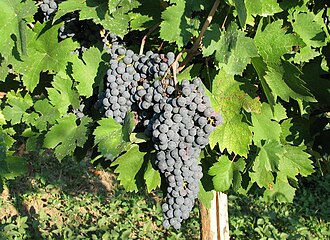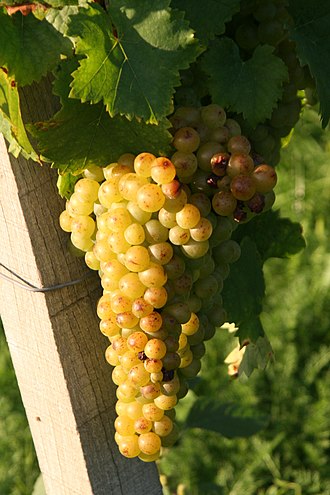Colli Piacentini
Italian wine region

The Colli Piacentini is a renowned wine region located in the Emilia-Romagna region of northern Italy. This area is celebrated for its diverse range of wines, which are produced in the hills surrounding the city of Piacenza. The region benefits from a unique combination of climate, soil, and grape varieties, contributing to its distinctive wine profile.
Geography and Climate[edit]
The Colli Piacentini region is characterized by its rolling hills and fertile valleys. The Apennine Mountains to the south provide a natural barrier, influencing the local climate. The region experiences a continental climate with hot summers and cold winters, which is ideal for viticulture. The Po River to the north also plays a role in moderating temperatures and providing necessary irrigation.
Grape Varieties[edit]
The Colli Piacentini DOC (Denominazione di Origine Controllata) encompasses a wide variety of grape types, both indigenous and international. Some of the most notable grape varieties include:
- Barbera: A red grape known for its deep color and high acidity, often used in blends.
- Bonarda: Another red variety, contributing to the region's robust red wines.
- Croatina: A red grape that adds tannins and structure to wines.

- Malvasia: A white grape variety that produces aromatic and floral wines.
- Ortrugo: A native white grape, often used in sparkling wines.
- Trebbiano: A versatile white grape, contributing to both still and sparkling wines.
Wine Styles[edit]
The Colli Piacentini region is known for producing a wide range of wine styles, including:
- Red Wines: Often made from Barbera, Bonarda, and Croatina, these wines are typically full-bodied with rich flavors.
- White Wines: Produced from Malvasia, Ortrugo, and Trebbiano, these wines are known for their freshness and aromatic qualities.
- Sparkling Wines: The region also produces sparkling wines, particularly from Ortrugo and Malvasia, which are appreciated for their effervescence and lightness.
History[edit]
The history of winemaking in the Colli Piacentini dates back to ancient times. The region was influenced by the Etruscans and later the Romans, who cultivated vineyards extensively. The tradition of winemaking has been passed down through generations, with modern techniques now complementing traditional methods.

Cultural Significance[edit]
Wine is an integral part of the local culture in the Colli Piacentini. The region hosts numerous wine festivals and events throughout the year, celebrating its rich viticultural heritage. These events attract both locals and tourists, offering a taste of the region's diverse wine offerings.
Related Pages[edit]

Ad. Transform your life with W8MD's Budget GLP-1 injections from $75


W8MD offers a medical weight loss program to lose weight in Philadelphia. Our physician-supervised medical weight loss provides:
- Weight loss injections in NYC (generic and brand names):
- Zepbound / Mounjaro, Wegovy / Ozempic, Saxenda
- Most insurances accepted or discounted self-pay rates. We will obtain insurance prior authorizations if needed.
- Generic GLP1 weight loss injections from $75 for the starting dose.
- Also offer prescription weight loss medications including Phentermine, Qsymia, Diethylpropion, Contrave etc.
NYC weight loss doctor appointmentsNYC weight loss doctor appointments
Start your NYC weight loss journey today at our NYC medical weight loss and Philadelphia medical weight loss clinics.
- Call 718-946-5500 to lose weight in NYC or for medical weight loss in Philadelphia 215-676-2334.
- Tags:NYC medical weight loss, Philadelphia lose weight Zepbound NYC, Budget GLP1 weight loss injections, Wegovy Philadelphia, Wegovy NYC, Philadelphia medical weight loss, Brookly weight loss and Wegovy NYC
|
WikiMD's Wellness Encyclopedia |
| Let Food Be Thy Medicine Medicine Thy Food - Hippocrates |
Medical Disclaimer: WikiMD is not a substitute for professional medical advice. The information on WikiMD is provided as an information resource only, may be incorrect, outdated or misleading, and is not to be used or relied on for any diagnostic or treatment purposes. Please consult your health care provider before making any healthcare decisions or for guidance about a specific medical condition. WikiMD expressly disclaims responsibility, and shall have no liability, for any damages, loss, injury, or liability whatsoever suffered as a result of your reliance on the information contained in this site. By visiting this site you agree to the foregoing terms and conditions, which may from time to time be changed or supplemented by WikiMD. If you do not agree to the foregoing terms and conditions, you should not enter or use this site. See full disclaimer.
Credits:Most images are courtesy of Wikimedia commons, and templates, categories Wikipedia, licensed under CC BY SA or similar.
Translate this page: - East Asian
中文,
日本,
한국어,
South Asian
हिन्दी,
தமிழ்,
తెలుగు,
Urdu,
ಕನ್ನಡ,
Southeast Asian
Indonesian,
Vietnamese,
Thai,
မြန်မာဘာသာ,
বাংলা
European
español,
Deutsch,
français,
Greek,
português do Brasil,
polski,
română,
русский,
Nederlands,
norsk,
svenska,
suomi,
Italian
Middle Eastern & African
عربى,
Turkish,
Persian,
Hebrew,
Afrikaans,
isiZulu,
Kiswahili,
Other
Bulgarian,
Hungarian,
Czech,
Swedish,
മലയാളം,
मराठी,
ਪੰਜਾਬੀ,
ગુજરાતી,
Portuguese,
Ukrainian